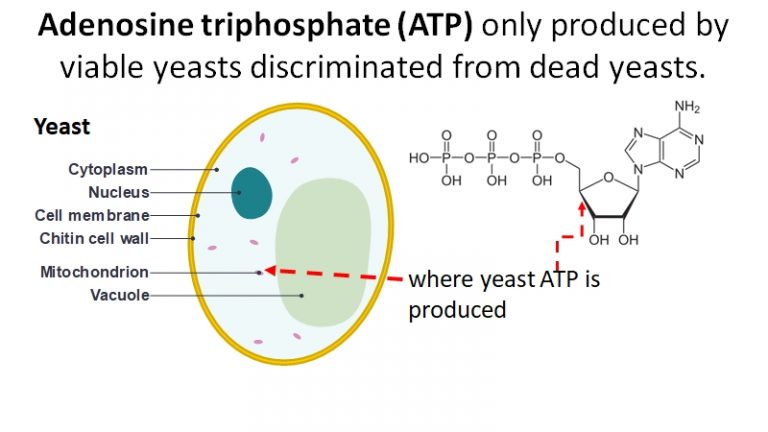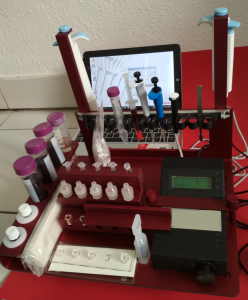Rapid on-site detection of viable Brettanomyces wine spoilage risks: million dollars of savings.
An innovative rapid on-site viable microbial beverage spoilage detection becomes a game changer.
This Brett Alert user-friendly on-site technology:
- detects selectively pre-critical thresholds of only viable spoilage microorganisms (Brettanomyces, lactic acid bacteria, acetic acid bacteria)
- solves PCR tests kits issues with false positives triggered by dead microorganisms when analyzing Brettanomyces bruxellensis, pediococcus & lactobacillus.
- solves PCR tests kits false negatives when PCR is inhibited by polyphenols & tannins
- allows immediate corrective action before reaching critical levels.
How does rapid viable Brettanomyces detection by selective Atp bioluminescence detection works?
Brett Alert kit detects rapid viable Brettanomyces where Bretts are the major yeast population during wine aging.. To the contary of aerobic yeasts near the bunghole surface, Brettanomyces thrive in bottom wine lees. Bretts are scarce near the bunghole surface, as also in the middle of the wine barrel.
Although Brett Alert reagents do not specifically discriminate Brettanomyces from other yeasts, it analyzes bottom wine samples where Brett are the major population during wine aging. This is a guarantee that bioluminescence detection come essentially from viable Brettanomyces.. Therefore Brett Alert can be used as an efficient abnormal Brettanomyces yeast growth alert tool.
Unlike Real-Time PCR - Brett Alert discriminates live Bretts from dead Bretts …

Intracellular yeast ATP is only produced if yeasts are alive. Measuring ATP from yeasts is therefore a good method to discriminate live Brettanomyces from dead Brettanomyces yeasts. Higher the bioluminescence reaction measured, larger the size and number of live Brett yeasts cells.
Brett Alert Atpbioluminescence correlation with viable Brettanomyces.
To find the correlation between the Atp bioluminescence signal detected with Brett Alert, it is important first to evaluate the average size of Brettanomyces cells and to compare them with Saccharomyces cerevisae strains.
Why so? because the litterature gives an average size of Saccharomyces ATP content averaging around 100 femtograms (fg) of ATP. To compare one single bacteria cell in wine average 1 fg.

The photos and graph on the left compare the size of Brettanomyces Bruxellensis (Cantillon iris C3 strain) to Saccharomyces cerevisae (Safale US-05 top fermentation strain) and Saccharomyces pastorianus (wy2206 bottom fermentation strain).
The Bretts are 3 times smaller (in diameter) than the top-fermenting strain US-05.
Assuming that the cells are spherical based on their average diameter, their average volume would be respectively
- 455 μm3 for Sach cerevisae strain US-05
- 82 μm3 for Sacch cerevisae strain WY2206
- 22 μm3 for Brettanomyces strain C3.
Saccharo Safale strain US-05 would be 20 times larger than Brett C3 and Saccharomyces pastorianus (strain WY2206) would be 5 times larger than a normal medium-sized Brettanomyces bruxellensis.

The intracellular ATP content of an average Brett cell which is not entering a viable but not culturable cycle, will have between 5 fg to 20fg of intracellular ATP per cell.
Making a ATP calibration curve of the bioluminometer will allow to know the average amount of average Brettanomyces bruxellensis cell in the wine sample.
The Atp bioluminescence background noise of the wine sample with the ATP conversion chart into femtogram of Atp, will be substracted from the Atp values of the wine sample will give you the average number of Brettanomyces bruxellensis .
Brett Alert discriminates real VNC Brettanomyces from dead Brettanomyces
VNC Brettanomyces cells will still be detected by Atp bioluminescence, although their size shrinks. Brett Alert will discriminate VNC Brettanomyces cells from dead Brett cells.
Very often PCR overestimate the real number of VNC Bretts because PCR is not able to discriminate genome units from dead and living cells.
A very easy way to test Brett Alert and PCR to see their ability to discriminate dead Bretts from living , is to analyze Brettanomyces treated with a high concentration of sulfur dioxyde, where we are sure Brettanomyces are dead and compare both results.
A very efficient alert tool of abnormal Brettanomyces bruxellensis growth.

Any yeast ATP increase following alcoholic fermentation during malolactic fermentation and during wine aging is the sign of an abnormal Brett growth.
Comparing yeast ATP values in wine past alcoholic fermentation with allow to detect any unforeseen Brett increase and allow winemaker to take immediate corrective action.
As an example Yeast ATP bioluminescence increased after wine racking indicating a Brett growth.
Normally each wine racking should reduce the viable yeast content, so with Brett Alert you know exactly what is going on.
How does Brett Alert detection kit work?

Brett Alert kit use patented selective Atp bioluminescence technology, to extract and analyze yeast ATP within 30 minutes without analyzing ATP of wine bacteria, instead of waiting 7 days agar plate count results. Analyzed samples are sampled with the Brettsampler just above the lees, where the Bretts are at majority during wine aging.
Brett Alert combines
- use of the wine sampling kit Brettsampler during wine aging to sample wine just above wine lees where Brett yeast are at majority, and
- with a unique selective Atp bioluminescence technology discriminating yeast from wine bacteria.

Step 1: collect bottom wine sample & concentrate Brett yeasts



Step 2: concentrate & flush inhibiting substances + free ATP


Brett Alert concentrates Brett yeasts and removes most polyphenols & tannins, as well as free Atp
Step 3: release yeast ATP (whose majority are Brettanomyces)
Step 4: measure yeast ATP bioluminescence.


Brett Alert YLC reagent extracts ATP from Bretts yeast during wine aging.
Reagents engineering makes it possible not to release and measure lactic/acetic bacteria ATP, but only yeast ATP.
Once Yeast ATP is released inside cuvette cuvette is introduced inside Wine Alert lab bioluminometer drawer slide and yeast ATP is mixed with Luciferin-luciferase. Drawer slide and instrument measure the light emission n Relative light units.
A preliminary calibration of instrument with Atp dilutions allows to correspond the amount of bioluminescence detected to the corresponding yeast Atp quantity and correlate it the average yeast cell population.
Wine Alert lab: a winemaker user-friendly tool for Brett analysis in wine cellars
Brett Alert kits are used with our Wine Alert field lab.
This lab was designed to allow winemakers not being necessarily a skilled lab technicien to perform on site wine analysis, to have an immediate response without having to send wine samples to the lab.,
Wine Alert field lab secures all equipments and consumables for the wine analysis, to avoid cross-contamination risks. A high sensitivity bioluminometer is secured by adapted field lab foodprint and fixtures which can be easily unscrewed.
Wine Alert field lab is autoclavable and can be easily dismounted, and unscrewed, and placed into its carrying case.

Brett Alert selective Atp bioluminescence evaluate Bretts spoilage potential…

Brettanomyces (or Bretts) are polymorphic yeasts cells, some form clusters, long chains, or pseudo-hyphae., Others are very small. Bretts nuisance factor depends not only on number of viable Bretts, but also on their size.
Major concern is the presence of viable but non culturable (vnbc) Brettanomyces cells, however scientific bibliography reveal that vbnc Bretts will not have a very important of ethylphenol production, in wine compared to a large pseudo-hyphae viable Brettanomyces yeast cell.
A tiny Brett cell, and a Bretts cluster, can be compared to two chemical plants that produce the same ethylphenols:
- a single small viable VNBC Brettanomyces yeast cell has only one line of production,
- while the other full grown and large Brettanomyces has fifty of them.
Larger the size of the viable Bretts, higher their intracellular ATP amount will be, and higher the ATPbioluminescence of these viable Bretts will be too.
Brett Alert alone is the sole ATP bioluminescence tool to measure total intracellular activity of all viable Bretts in the sample and thus assess their harming potential varying from one sample to the other. It also will trigger an alert in case these vnbc Brettanomyces starts to reactivate, as their cell size will growh and their intracellular ATP production will increase.
Next page Brett Alert validation
